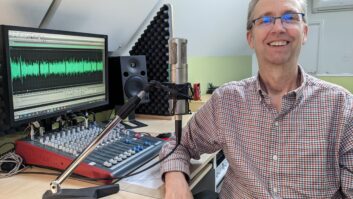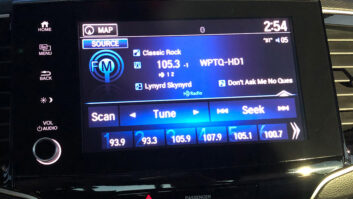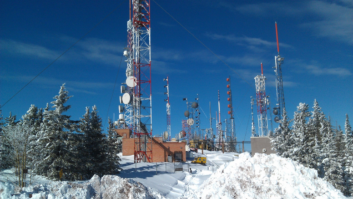LINCOLN, Neb. For thse unfamiliar with it, 25-Seven Systems’ Audio Time Manager (ATM) is a unique, TiVo-like device that can continuously record an hour’s worth of audio, and simultaneously play back from any point in that buffer. It can play back in real time, or faster than real time using time compression algorithms that are almost inaudible to even a careful listener.
ATM lets us “pause” the network or other live feeds, insert content, then pick up where we left off without losing anything. ATM’s remote control options make integration so simple that it’s practically an extension of our audio console.
Pleasant surprises

The author and the 25-Seven ATM in its rack at NET Radio.
When NET Radio, a Nebraska-based public radio broadcaster, originally considered the Audio Time Manager, the suggestion was to use it to compensate for programming lost during Emergency Alert System tests and events. We were surprised with the performance and audio quality of the ATM during the demo, and agreed to put it in our budget for the next year.
While covering EAS events was the initial impetus, ATM provided us with the solution to a bigger and more chronic problem: Severe Weather Warnings.
On the northern edge of Tornado Alley, Nebraska can see severe thunderstorm activity on any given afternoon between May and September. Since NET Radio has nine transmitters and six translators serving 91 of Nebraska’s 93 counties, we have a lot of ground to cover for storm warnings. The prime hours of these storms just happen to coincide with our most popular programming. The incessant and lengthy interruptions for storm warnings are considerably vexing to the listener, especially when a weather event on the western edge of our large state disrupts programming for listeners on the eastern side. Or vice-versa.
While the ATM can integrate with automation systems and other devices for automatic use, we implement it in a discretionary capacity. This gives the operator the most control of when and how to use it.
Once we decided on how we wanted to use the ATM, installation was fairly easy. The ATM’s AES outputs are connected to a digital input on our console, and a pre-fader bus send routed to the ATM’s input. The console operator can choose any source on the console to feed the ATM, from real-time satellite feeds to programs played out from our audio server.
For easy command of the unit, the ATM’s GPIO interface is connected to the GPIO of our console’s control surface, and operated from the Fader Start/Stop controls on the ATM’s console strip. To make it easier for multiple start and buffer events, the Fader Stop relay closure starts the ATM’s “record” buffering mode, and the Fader Start relay closure triggers ATM playback.
Simple operation
When the ATM is needed, the operator routes the source to be buffered to the ATM’s bus. Then the operator simply presses the Fader Stop button on the ATM’s console channel strip to start buffering the routed source.
The original source is potted down. The necessary announcement is made and the operator pots up the ATM’s channel fader. The Fader Start triggers the ATM playback. With this fader control setup, if the operator needs to make another announcement before the ATM is back in real-time sync, the operator can pot down the ATM’s fader, and resume buffering seamlessly.
The operator has the option of adjusting the in point for the buffered audio with a great cue function. So, even if the operator started recording the buffer a little late, a quick cue from the ATMs front panel can recover the missed audio.

Rear panel The time compression rate can be controlled by the operator as either a rate of minutes per hour, or adjusted to resume real-time playback at a specific time. This allows an operator to regain time and be confident to hit a specific time mark, or adjust the compression to suit the program. We typically have the compression set to 10 percent (six minutes/hour), but can accelerate it to our in-house maximum of 20 percent (12 minutes/hour) for some material. We can also set the compression to 0 minutes/hour to provide a straight delay when we need to just time-shift a program.
While weather warning breaks are the predominant use of our ATM, we’ve used it to lengthen local news breaks to accommodate longer local inserts, create more pitching opportunities during membership drives, and to time-shift entire programs.
We have the ATM connected to our LAN for NTP time synchronization.
I should also mention the occasional software update from 25-Seven Systems. The software update process is easy. We just forward a port through our firewall, so 25-Seven Systems can login via SSH, and then they have access to the ATM over the network. LAN utilities also include a browser-based Web GUI for remote operation.
Audio Time Manager has improved our service to our listeners. The ATM has enabled us to get critical information to our audience without sacrificing program content.
James Duchesneau is production coordinator for NET Radio.
For more information, contact 25-Seven Systems at (617) 789-4673, or visit www.25-seven.com.












